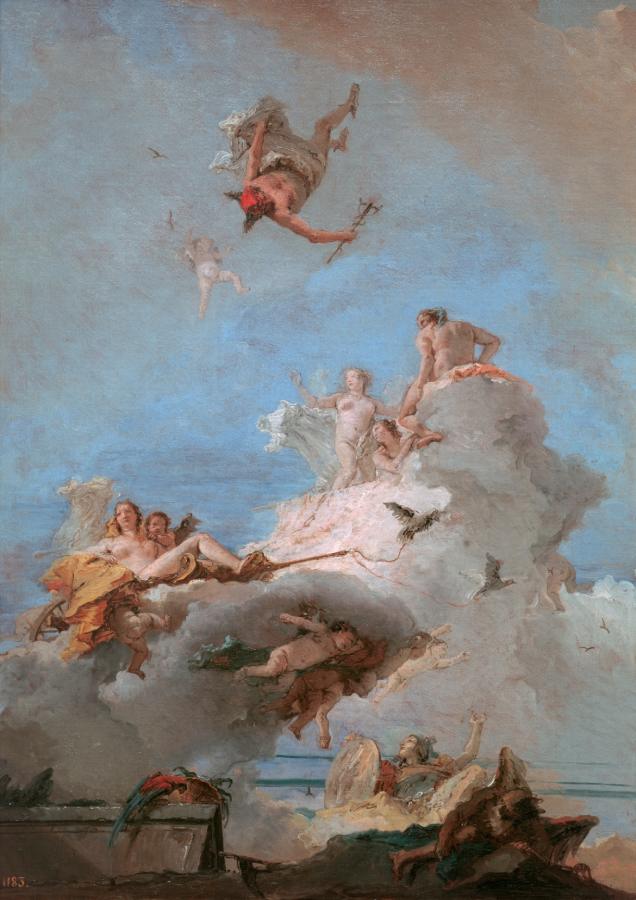Tiepolo, Giambattista (1696-1770)
L’Olimpo, o Trionfo di Venere (The Olympus or Triumph of Venus)
1761–1764
Oil on canvas, 87 x 61.5 cm
Museo del Prado, Madrid
This is a sketch for a no-longer extant painting on canvas intended to decorate a ceiling in a building of the imperial court of Russia, whose memory is preserved in an engraving made by Giambattista‘s youngest son Lorenzo. The engraving forms a set with another three, two of which were also made by Lorenzo, on the basis of original works by his father, as part of the same commission. The engravings thus reproduce four paintings, now unknown, that were executed for the mansion of Count Mikhail Vorontzov, chancellor of the imperial court, according to Artemieva (1998), one of which, Mars and the Three Graces (or Mars resting) was seen by Sack at the beginning of the 20th century (1910) in the Chinese Palace in Oranienbaum, on the outskirts of St Petersburg. The Prado sketch is therefore the only one that remains of the group. The other two depicted The Magnificence of Princes and The Triumph of Hercules. The final works were sent to the capital in summer 1759. Venus is portrayed on the left, reclining in a chariot pulled by doves. On the right, amid the clouds, are the three Graces and beneath them, also on the right, Minerva and Cronos contemplate their triumphal passage while Mercury swoops down from above. The bold architectural foreshortening in the lower left area -partially occupied by a parrot- creates an illusionary effect of continuity between earth and heaven. The absence of all the other deities of Olympus and the privileged position given to the god of love lead the scene shown in this work to be interpreted as the triumph of Venus. The rich range of colours is based on grey, yellow, blue and green tones and is illuminated by the patches of colour created by the crimson of the messenger of the gods’ helmet and by the red and green plumage of the bird. It should not be forgotten that Tiepolo worked on a painting for the ceiling of a Moscow palace, as he tells in a letter sent to Francesco Algarotti from Venice (16 March 1761) in which he complains of being overwhelmed by his many commitments. The mention that he was still working on a large painting for a ceiling of the court of Moscow appears to be a reference to Empress Elizabeth Petrovna, for whom Tiepolo was painting in 1760 -with a style more characteristic of Rosalba Carriera– half-size figures of women’s capriccios. Ernst’s hypothesis (1963) that the figure of Venus conceals the portrait of the tsarina herself, known through a contemporary engraving, is unique and stems from the aristocrat’s desire to pay tribute to the sovereign’s beauty. The painting recalls the illusionary backdrops of ceiling paintings in the Villa Valmarana in Vicenza and Ca’ Rezzonico in Venice, and of a now destroyed painting in the Palazzo Canossa in Verona. A notable feature is the simplicity of the composition which, according to Pallucchini (1968), with few figures allows the master to gently draw a perfect wandering line and to plunge the images into a vibrant atmosphere, into a light which penetrates the forms without any violence. Nor can it be said that Gaya Nuño (1961) exaggerates when fully savouring Tiepolo‘s irresistible attraction in the small Prado painting: that drawing […] masterfully vibrant yet confident, sketches each limb, each line and cloud with infinite delicacy […]; the faint and light colour, like that of dawn, creates in any work by Tiepolo, and even in a simple sketch like this one, an almost superhuman sensation of a fresh spring morning (Text drawn from Luna, J. J.: From Titian to Goya. Great Masters of the Museo del Prado, National Art Museum of China-Shanghai Museum, 2007, p. 376).
